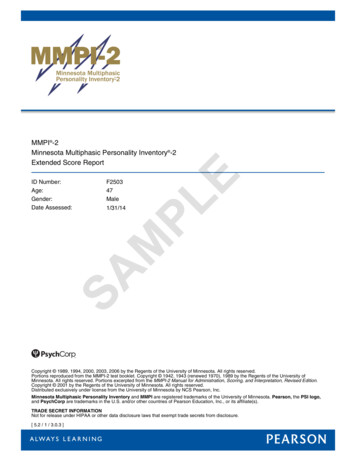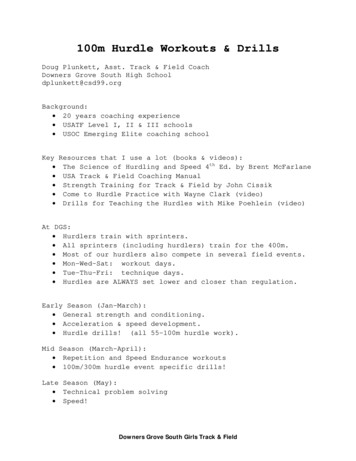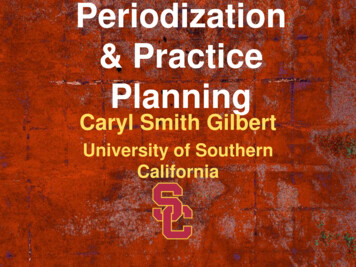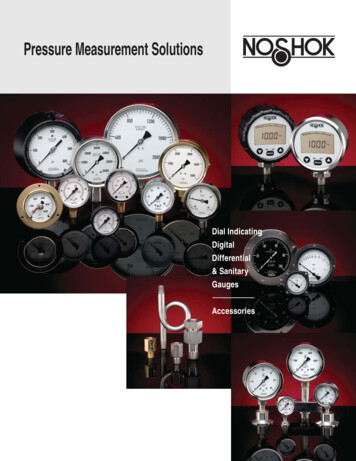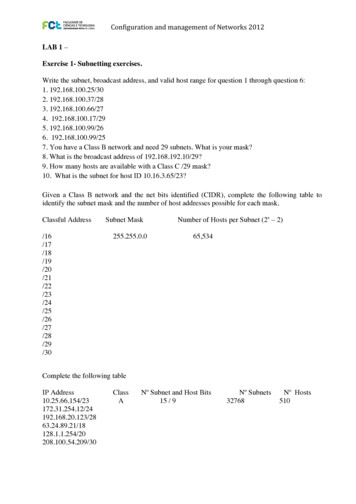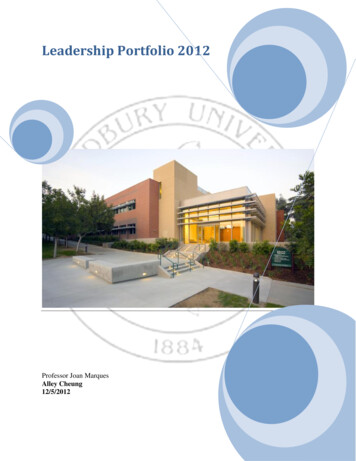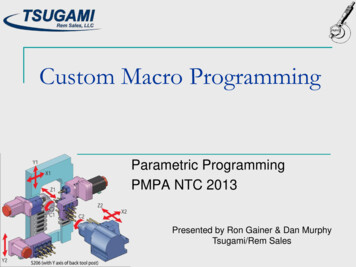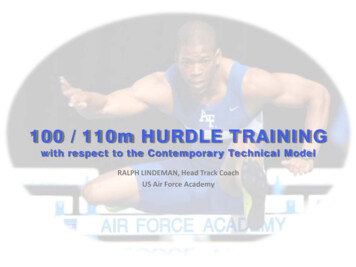
Transcription
100 / 110m HURDLE TRAININGwith respect to the Contemporary Technical ModelRALPH LINDEMAN, Head Track CoachUS Air Force Academy
100 / 110m HURDLE TRAININGwith respect to the Contemporary Technical ModelRalph Mann’s research has identified that successful hurdlers must:1) Minimize time from start to take-off to 1st Hurdle Manage StepsoooReach proper take-off distance to the 1st hurdleGenerate highest horizontal velocity possible to that distanceMinimize time from start to take-off to 1st Hurdle2) Minimize Hurdle Clearance time Begin from proper take-off distance to the 1st hurdleMinimize ground time into and off of the hurdleMinimize air time over the hurdleLose as little horizontal velocity as possible over the hurdle3) Minimize time for the 3 steps between hurdles Manage StepsooReach proper take-off distance to the next hurdleRegain highest amount of horizontal velocity as possible over those 3 steps4) Utilize mechanics to get the most out of the Hurdle Clearance Maximize front-side mechanicsMinimize back-side mechanics
100 / 110m HURDLE TRAININGwith respect to the Contemporary Technical ModelFrom Ralph Mann’s conclusions from his video study,he’s identified the following “coaching issues”:1) The importance of the Start is too often ignored.2) Training has been dominated by sprint activity over Hurdle activity.3) The traditional core concepts of Hurdle technique are flawed.4) The mechanics of the steps between the Hurdles has been ignoredand any specific training virtually ignored.
100 / 110m HURDLE TRAININGwith respect to the Contemporary Technical ModelIMPLICATIONS for TRAINING
100 / 110m HURDLE TRAININGwith respect to the Contemporary Technical ModelIMPLICATIONS for TRAINING1) Practice the Start at least 2 times a week In preparation for Hurdling, every time you HurdleIndividually, with the focus on mechanics (vs. competition)As a group, in a competitive environment2) Teach the most effective (FASTEST!) start for that specific athlete 1st 3 stepsMeasure touchdown preceding 1st hurdle3) Provide constant feedback to the athlete TEACH: Verbal feedbackTEACH: Video feedbackTIME: 3m, or, 3rd step touchdown; touchdown preceding hurdle clearance
100 / 110m HURDLE TRAININGwith respect to the Contemporary Technical Model7- vs. 8-step Approach Models
100 / 110m HURDLE TRAININGwith respect to the Contemporary Technical Model7- vs. 8-step Approach Models
100 / 110m HURDLE TRAININGwith respect to the Contemporary Technical Model“The Hurdles are NOT a Sprint” Ralph Mann
100 / 110m HURDLE TRAININGwith respect to the Contemporary Technical Model“The Hurdles are NOT a Sprint”HurdleDescription ClearanceStrideΔD3.48mfrom Hurdle3rd Stridefrom HurdleHurdleClearanceStride2.14m2.04m3.48m1st Stride2nd Stride1.48mfrom Hurdle Ralph Mann
100 / 110m HURDLE TRAININGwith respect to the Contemporary Technical Model“The Hurdles are NOT a Sprint”HurdleDescription ClearanceStrideΔD% of D between3.48m Ralph Mannfrom Hurdle3rd Stridefrom 38%35%1st Stride2nd Stridefrom Hurdle
100 / 110m HURDLE TRAININGwith respect to the Contemporary Technical Model“The Hurdles are NOT a Sprint”HurdleDescription ClearanceStride Ralph Mannfrom Hurdle3rd Stridefrom HurdleHurdleClearanceStride1.48m2.14m2.04m3.48m% of D huffle”Step“Drop”StepΔD3.48m1st Stride2nd Stridefrom Hurdle
100 / 110m HURDLE TRAININGwith respect to the Contemporary Technical Model“The Hurdles are NOT a Sprint”43.532.521.510.50Hurdle1st Step fromClearance StrideHurdle"Fall Step"2nd Step fromHurdle"Shuffle Step"3rd Step fromHurdle"Drop Step" Ralph Mann
100 / 110m HURDLE TRAININGwith respect to the Contemporary Technical Model“The Hurdles are NOT a Sprint” Ralph MannStride Lengths in a 110m Hurdle Race (m)432108 10 12 14 16 18 20 22 24 26 28 30 32(H1)(H2)(H3)(H4)(H5)(H6)
100 / 110m HURDLE TRAININGwith respect to the Contemporary Technical Model“The Hurdles are NOT a Sprint” Ralph MannStride Lengths in a 110m Hurdle Race (m)432108 10 12 14 16 18 20 22 24 26 28 30 32(H1)(H2)(H3)(H4)(H5)(H6)
100 / 110m HURDLE TRAININGwith respect to the Contemporary Technical Model“The Hurdles are NOT a Sprint” Ralph MannStride Lengths in a 110m Hurdle Race (m)432108 10 12 14 16 18 20 22 24 26 28 30 32(H1)(H2)(H3)(H4)(H5)(H6)Ten (10) Decelerations Eleven (11) Accelerations
100 / 110m HURDLE TRAININGwith respect to the Contemporary Technical Model“The Hurdles are NOT a Sprint” Ralph MannStride Lengths in a 100m Sprint Race (m)432108 10 12 14 16 18 20 22 24 26 28 30 32(H1)(H2)(H3)(H4)(H5)(H6)
100 / 110m HURDLE TRAININGwith respect to the Contemporary Technical ModelSlide from 2010 Presentation
100 / 110m HURDLE TRAININGwith respect to the Contemporary Technical ModelSlide from 2010 Presentation
100 / 110m HURDLE TRAININGwith respect to the Contemporary Technical ModelIMPLICATIONS for TRAINING
100 / 110m HURDLE TRAININGwith respect to the Contemporary Technical ModelIMPLICATIONS for TRAININGSOLUTION to the “SPRINT vs HURDLE ISSUE”1) Most “speed work” should be done within the hurdle stride length(or stride pattern RL) constraints Stride rate (“speed”) training– at race ratesStride length training– at standard distance, but lower heights3) Provide constant feedback to the athlete TEACH: Verbal feedbackTEACH: Video feedbackTIME: 3m or 3rd step touchdown; touchdown preceding hurdle clearance2) Teach the most effective model for each particular athlete Hurdle techniqueStep pattern
100 / 110m HURDLE TRAININGwith respect to the Contemporary Technical ModelIMPLICATIONS for TRAININGLots & lots of RhythmicHip Mobility Drills
100 / 110m HURDLE TRAININGwith respect to the Contemporary Technical ModelIMPLICATIONS for TRAININGEmphasis should be onF-A-S-T Hurdling
100 / 110m HURDLE TRAININGwith respect to the Contemporary Technical ModelIMPLICATIONS for TRAININGFor increased Stride Frequencybetween hurdles, try reps over hurdles with reduced spacing:College Men:13m to 1st hurdle,8.5 - 8.8m betweenHS Boys:12.5m to 1st hurdle, 8.3 - 8.5m betweenCollege Women:12.5m to 1st hurdle, 8.0 - 8.3m betweenHS Girls:12m to 1st hurdle,7.8 - 8.0m between
100 / 110m HURDLE TRAININGwith respect to the Contemporary Technical ModelIMPLICATIONS for TRAININGFor increased Velocitybetween hurdles, try 10 strides to the 1st hurdle and 5 between hurdles:College Men:17m to 1st hurdle, 13m betweenHS Boys:16m to 1st hurdle, 12.5m betweenCollege Women:16m to 1st hurdle, 11.5m betweenHS Girls:15.5m to 1st hurdle, 11m between
100 / 110m HURDLE TRAININGwith respect to the Contemporary Technical ModelIMPLICATIONS for TRAININGFor both increased StrideFrequency and inceased VelocityLower the hurdles keeping the hurdles the standard distance apart:12” Banana Hurdles 24” Scissor Hurdles 30”, 33”, 36”, 39” Standard Hurdles
100 / 110m HURDLE TRAININGwith respect to the Contemporary Technical ModelIMPLICATIONS for TRAININGDon’t ignore “Bounding”
100 / 110m HURDLE TRAININGwith respect to the Contemporary Technical ModelIMPLICATIONS for TRAININGDon’t ignore “Bounding”1) A-bounds teach Hurdle Technique,most importantly, fast lead knee and fullextension of drive leg.2) Bounding is invaluable for buildingexplosive strength needed for optimalstride length in Hurdling.
100 / 110m HURDLE TRAININGwith respect to the Contemporary Technical ModelOTHER VIEWS on TRAINING
QUESTIONS?100 / 110m HURDLE TRAININGwith respect to the Contemporary Technical ModelRALPH LINDEMAN, Head Track CoachUS Air Force Academye-mail: ralph.lindeman@usafa.edu
2) Training has been dominated by sprint activity over Hurdle activity. 3) The traditional core concepts of Hurdle technique are flawed. 4) The mechanics of the steps between the Hurdles has been ignored and any specific training virtually ignored.
